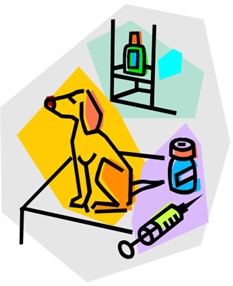
Otitis Externa (OE) is an ear condition characterised by inflammation of the ear canal, and occasionally the pinna (outside flap of the ear).
Symptoms include:
- Head shaking
- Scratching at the ears
- Redness and swelling in the ear canal
- Discharge from the ears
- Foul odor
- Pain when the ears are touched or rubbed
- Loss of hearing or balance
If the ear canal is narrowed, this can encourage infection from bacteria and yeasts. It can affect both ears at once or just one and can be acute (sudden onset) or chronic (long-term).
What causes it?
– Parasites (e.g. the ear mite, Otodectes cyanotes)
– Allergies (food allergies, environmental allergies, contact hyper-sensitivities)
– Trauma (excessive ear cleaning or scratching)
– Endocrine disease (e.g. hypothyroidism)
– Foreign bodies (e.g. grass seeds)
– Aural polyps
-Cancer
The most common cause is allergies (atopic dermatitis).
The main perpetuating factor is bacteria (most commonly Staphylococcus spp and Pseudomonas spp) and yeasts (most commonly Malassezia spp). If the infection spreads it can reach the middle ear (past the eardrum), causing a condition called otitis media.
Risk:
Dogs with longer ears are more at risk of developing otitis externa, such as Basset Hounds and Beagles. Dogs with erect ears have a lesser risk than other breeds. Brachycephalic breeds, like the Pug or French Bulldog, are more likely to develop otitis externa.
Dogs who are predisposed to atopic dermatitis are also predisposed to otitis externa. In addition, dogs exposed to moisture, such as through regular swimming, are at increased risk. Dogs who are overweight, or produce more cerumen (ear wax) are also at risk.
How is it diagnosed?
Otitis externa is often clearly visible on a physical examination. An ‘otoscope’ – a piece of equipment with a light to look down a dog’s ear canal – is used to see the extent of the inflammation, any signs of infection or foreign bodies and to see if the tympanic membrane (ear drum) can be seen. Sometimes taking samples of the cells inside the ear canal is useful to understand which germ is causing the problem. These samples are usually looked at under a microscope and can be sent away for culturing, which will help to target appropriate treatment. If the otitis is severe and very painful, some dogs require sedation or a general anaesthetic in order to properly assess the ear canal and the tympanic membrane.
How can otitis externa be treated or managed?
Usually, this is treated by reducing the inflammation in the ear canal by using anti-inflammatories, alongside painkillers (analgesia) and appropriate anti-microbials (antibiotics, antifungals, or anti-parasitics). Most topical ear preparations contain a combination of medications. Some of these medications are known as ‘ototoxic’ and should not be used if the tympanic membrane is not intact. If a vet cannot see to the tympanic membrane and suspects it is ruptured, or the ear canal is very narrow, they may use oral medication instead of topical. Management of the underlying cause is important. For example, if allergies are suspected, appropriate treatment should be commenced to manage recurrent otitis. In very severe cases, where medical management is ineffective, surgery may be indicated: a Lateral Wall Resection opens up the ear canal, and a Total Ear Canal Ablation removes the whole of the diseased and chronically inflamed tissue.
Overall, appointments with a vet are crucial to effective diagnosis and subsequent treatment of otitis externa. It is important to continue to attend follow-up appointments to help manage the condition and ensure any underlying conditions are accounted for. By working closely with your vet, you can help ensure that your furry friend stays healthy and happy.
Dr Arielle Johnson BSc(Hons) BVetMed MRCVS
Willett House Veterinary Surgeons
